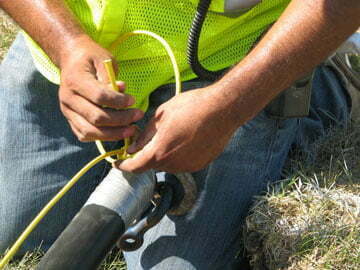Urban underground plastic pipes play an important role in every modern city. It is the infrastructure on which the city depends for its survival and development.
plastic pipes
- low temperature resistance
- Good toughness, rigid and flexible
- Convenient construction
- lower cost than copper pipes
- Corrosion resistance, and
- Small pollution to the transported material
However, although plastic pipes have many of the above-mentioned advantages, they also have a fatal weakness: low strength and easy to be destroyed.
Moreover, because the plastic pipe itself is non-conductive and non-magnetic. So far there is still no very effective method to directly detect its spatial location in the ground.
In the early municipal construction, it was not easy to identify the exact location of such pipelines. From time to time, the construction machinery will happen to cut, digging the leakage of the pipeline. And the resulting drowning, drowning gas and gas explosion accidents also occur from time to time.
To solve the problem of detecting and calibrating the location of underground plastic pipes. Tracer line method is currently a more common practice at home and abroad.
Specific approach is:
Place I (or 2) tracer lines directly above the pipe to be buried with the plastic pipe.
It provides a physical prerequisite for indirect detection of the location of the plastic pipe.
Selecting the right tracer line
In terms of detection theory, the tracer line is qualified as long as it conceals the following two points.
- Smaller resistance
- through 0.3 ampere current strength
However, when choosing it in the actual project, we also have to take into account that it has a certain tensile strength.
Otherwise there is a risk of pulling off when the construction team is backfilling the pipeline, or when there is subsidence in the ground.
Engineering practice has proven that we should choose copper-clad steel tracer wire with plastic insulation and a cross-sectional area of 2.0-2.5 mm².
It has good electrical conductivity, high strength and easy construction.
Please note that do not use those plastic film tracer tapes with warning signs. These tracer tapes have very fine wires inside and have the following disadvantages.
- Difficult to connect the two ends
- Difficult to form a complete good conductive network
- End grounding resistance is large
- Poor detection signal, difficult to detect
How to lay correctly
Firstly, bury the tracer wire in a straight line close to the PE pipe, preferably located above the pipe. Do not spiral winding on top of the pipe.
Secondly, at the outlet, set aside a length of more than 1 meter for later detection.
Thirdly, make the joints anti-corrosion treatment.
Then, reduce the grounding resistance of the buried end of the tracer wire.
Finally, if the length of buried pipeline exceeds one kilometer, set up a test stake and leave a tracer line joint per kilometer.
Detection Techniques
1.Preferred direct connection method. This method has less interference, easy tracking, and more accurate detection results.
2.Do not use the induction method in urban areas. The signal is easily covered.
3.Use a lower operating frequency for detection by direct connection
4.For the pipeline laid by directional drilling, the construction should minimize the resistance of the grounding end and increase the signal current of the tracer line.


